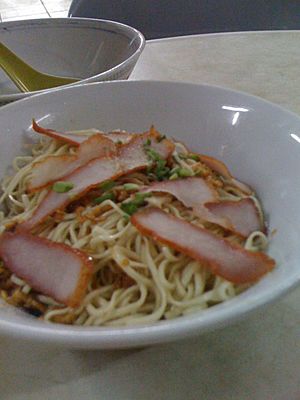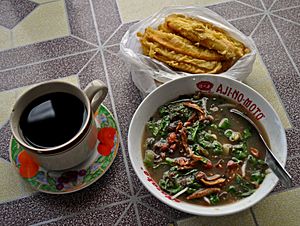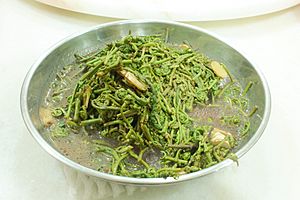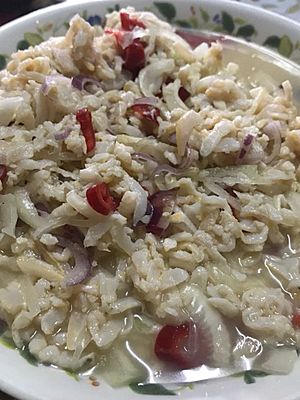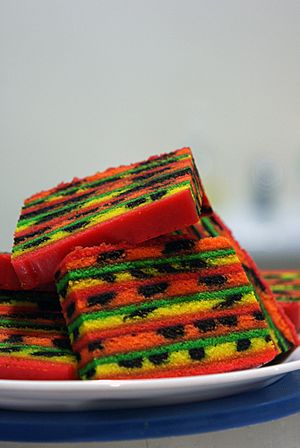Sarawakian cuisine facts for kids
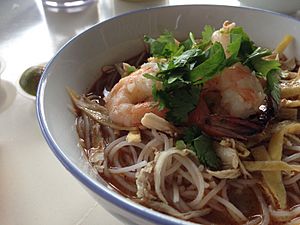
Sarawakian cuisine is a special type of food from Sarawak, a state in Malaysia. Just like other Malaysian foods, Sarawak dishes often use rice as a main ingredient. But what makes Sarawak food unique is its amazing variety of ingredients and cooking styles. This is because Sarawak has many different landscapes and native cultures, which are quite different from other parts of Malaysia. Sarawak is known for having many different ethnic groups. Each group has its own way of life, traditions, and, of course, delicious foods!
Sarawak food is usually less spicy and has a gentle taste. It often uses fresh seafood and natural herbs like turmeric, lemongrass, ginger, lime, and tapioca leaves. These ingredients are easy to find and add a wonderful smell, texture, and freshness to the dishes. Food is a big part of the culture for Sarawak's native groups. For example, the Iban people enjoy tubu (stems), tuak (a rice wine drink), and pansuh (food cooked in bamboo). The Malay people have bubur pedas (a type of porridge) and kek lapis Sarawak (Sarawak layer cake). The Bidayuh people like asam siok (chicken rice cooked in bamboo) and sup ponas Bidayuh (a soup with tapioca). The Melanau are known for tebaloi (sago crackers), sagu (from the sago palm), and umai (raw fish mixed with lime juice). And the Orang Ulu enjoy garam barrio (Highlands salt), kikid (broth), tengayen (local young leaves), and urum giruq (pudding).
Contents
Key Ingredients in Sarawakian Cooking
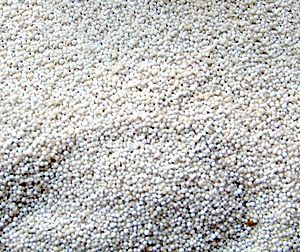
Sarawakian food often uses rice as its main ingredient. It's usually steamed and served with meat, fish, and vegetable dishes. People often enjoy the rice with the sauce or broth from the main dishes.
Special Rice Varieties
Bario rice is a famous rice from Sarawak. It's named after the highlands where it grows. Local people think it's the best and finest rice from the Sarawak highlands. Long ago, this rice was said to be eaten only by the longhouse chief on special days. Today, you can find it in many Sarawak restaurants.
Fried rice is also popular. Nasi aruk is a traditional Sarawakian Malay fried rice. Unlike other fried rice dishes, nasi aruk doesn't use much oil. The rice is fried for a longer time to get a smoky or slightly burnt taste.
Sago: A Traditional Staple
Sago or sagu is a main food for the Melanau people in Sarawak. The bud of the sago palm is cooked in traditional dishes. It's often sliced and stewed with coconut milk, dried anchovies, and spices.
Linut or sago porridge is made by pouring hot water into sago starch. It's usually served with sambal belacan (chilli paste) and other side dishes. This porridge is very gooey and sticky.
Tebaloi is a sweet Sarawak cracker. It's made from sago starch, egg, coconut, and sugar. It's flattened until thin and roasted until it's crispy. Tetubei is another sago dish, also a traditional Melanau food.
Fresh Fruits and Vegetables
Many dishes use a variety of fruits and vegetables. Midin, also called Stenochlaena palustris, is a popular vegetable in Sarawak. It grows well in sunny, swampy areas. Midin is usually stir-fried with garlic or belacan (shrimp paste). The most popular dish is midin goreng belacan.
Buah dabai, or Canarium odontophyllum, is a native fruit from Sarawak. It grows only on the island of Borneo, especially in the Rajang River area. It's a unique food in Sarawak. The dabai fruit is a bit bigger than an olive and has thin, bluish-black skin. Nasi goreng dabai is a special fried rice dish where buah dabai is the main ingredient. The rice is fried with soy sauce, garlic, shallots, chili, and oyster sauce, along with dabai and egg.
Tomatoes, garlic, and onions are used in many Sarawak dishes. The most important spice is pepper. Sarawak pepper is grown a lot and is a favorite for adding heat to dishes. It's known worldwide for its quality.
Other common ingredients include maize (corn), pumpkins, and yams. These are often grown near rice fields.
Meats and Seafood
Common meats include chicken, pork, beef, and fish. Seafood is very popular because Sarawak is surrounded by water. Popular catches include semah, ikan keli, baong, empuarah, and prawns.
People also eat meat from deer and wild boars. Some birds like punai are caught with sticky nets and roasted. Deep-fried punai is often found in lelapan (halal) meals in Miri.
Jungle vegetables are found in the forests and by rivers. Palms like pantu, nipah, nibong, coconut, and sago are important for their umbut or shoots, which are considered special foods. Sarawakian native food is known for its simple and direct flavors. Wild ginger, daun bungkang, and other jungle leaves add subtle tastes to dishes.
Traditional Cooking Methods
In Sarawak, common cooking methods include menumis (stir-frying), menggoreng (frying), bakar (grilling), and rebus (boiling). Each ethnic group has its own special ways of preparing, cooking, and preserving food.
For example, the Orang Ulu people use garam barrio (Highlands salt) to preserve meat, fish, and vegetables. This method is called mengasam. The Iban people cook and eat lulun, which is rice cooked inside bamboo.
Another traditional Iban cooking method is pansoh or pansuh. This involves preparing and cooking food in bamboo tubes. Ingredients like chicken, fish, vegetables, or rice are mixed with fragrant herbs like lemongrass, tapioca leaves, and bungkang leaves. Then, they are sealed inside bamboo tubes and placed over an open fire. This way of cooking makes the food moist and gives it a wonderful aroma and flavor from the bamboo. The large forest areas and traditional lifestyles of native groups have influenced how their unique foods are created and cooked using natural resources.
Popular Sarawakian Dishes
Some of the most popular dishes in Sarawak include Sarawak laksa, kolo mee, sayur midin belacan, tomato mee, linut, and ayam pansuh. The state is also famous for its Sarawak layer cake dessert. Each ethnic group has its own special foods with different cooking styles.
In September 2021, Sarawak Laksa was even named the best dish in Asia by readers of TasteAtlas!
Common Dishes to Try
Sarawak is well-known for its rice. Here are some other foods and drinks special to Sarawak:
- Acar timun Sarawak: This is a popular Malay pickled cucumber dish. It's different from other pickles because it's preserved in vinegar and sugar for a long time. This makes it sweet and sour, with flavors of turmeric and other spices. It's often eaten with fish crackers.
- Asam siok: A Bidayuh chicken and rice dish cooked in bamboo. It's often served during special events like Gawai. It includes chicken, rice, salt, ginger, lemongrass, and tapioca leaves.
- Bee pang: A crispy Chinese rice cake popular in Sarawak.
- Belacan bihun: Rice noodles mixed with a sauce made from chilies, shrimp paste, tamarind, and dried shrimp. It's topped with cured cuttlefish, cucumber, bean sprouts, and century egg.
- Bubur kapu: An Iban dessert made from rice flour, similar to chendol.
- Bubur pedas: A type of rice porridge cooked with a special spicy paste. It's often made during the month of Ramadan.
- Stir-fried cangkuk manis: Sweet leaf vegetables stir-fried with red peppers, shallots, garlic, oyster sauce, and egg.
- Daun ubi tumbuk: Pounded cassava leaves, similar to pesto. It's eaten by many native communities. The leaves can be stir-fried, cooked in bamboo, or boiled.
- Gula mitai: Sarawak's version of candy floss. It's made by melting sugar and then pulling and folding it as it cools.
- Ikan terubuk masin: Salt-preserved toli shad fish, a famous local delicacy.
- Kasam ensabi: A fermented vegetable pickle made from mustard greens, traditional for the Iban community.
- Kolo mee: Springy egg noodles tossed in a sweet and savory sauce. It's topped with seasoned minced pork and char siu (barbecued pork). Halal versions use beef or chicken instead of pork.
- Kompia: A Chinese bread filled with meat, onions, salt, and flour. It's baked in a traditional oven.
- Kuching Siew pau: A Chinese baked bun with a meat filling, popular in Kuching.
- Laksa Sarawak: Noodles (usually rice vermicelli) served in a fragrant spiced coconut milk soup. It's topped with shredded chicken, omelette, bean sprouts, prawns, and coriander. This dish was praised by American chef Anthony Bourdain.
- Linut: A main food for the Melanau people. It's made from sago flour mixed with hot water.
- Manok kacangma: A Chinese-influenced chicken dish cooked with ginger and kacangma (motherwort). It's traditionally eaten by women after giving birth.
- Manok pansoh: A typical Iban chicken dish cooked in bamboo. Chicken is seasoned with leaves, lemongrass, ginger, and tapioca leaves. It's roasted in a traditional fireplace.
- Mee sapi: A noodle dish similar to kolo mee, but served with a beef broth and topped with bean sprouts and beef slices.
- Midin: A vegetable dish where young fern fronds are stir-fried with garlic, dried shrimps, or shrimp paste.
- Nasi aruk Sarawak: A traditional Sarawakian Malay fried rice. It uses very little oil and is fried longer for a smoky taste.
- Nasi goreng dabai: Fried rice with dabai, a unique local fruit. It's often compared to an olive.
- Nasi goreng ikan terubuk masin: Fried rice served with fried salt-preserved toli shad fish.
- Nasi lelapan: A rice dish popular in Miri. It usually has a main dish (fried fish, chicken, or beef) with seven side dishes, mostly fresh vegetables, and sambal belacan (chilli paste).
- Nasi mak entek: A rice dish with chicken, baked beans, boiled egg, and sambal belacan. It's popular in Samarahan.
- Nuba laya: Cooked bario rice that is mashed and wrapped in leaves. It's a main part of a meal for the Lun Bawang and Kelabit people.
- Roti canai goreng Kapit: A unique fried flatbread from Kapit. It's fluffy inside and crispy outside, served with chicken curry and spicy sauce.
- Sio bee: Kuching's version of siu mai, popular among the Chinese. It's stuffed with pork.
- Sinamu baka: A traditional Lun Bawang/Lundayeh fermented food, specifically for wild bear meat.
- Sup Terung Dayak: A popular soup made with a native wild eggplant. This eggplant is round and tart. Other ingredients can include fish or prawns.
- Sup paku kubok: A hairy fern soup cooked with anchovy and ginger.
- Sup ponas Bidayuh: A Bidayuh soup made from tapioca, lemongrass, and other herbs.
- Tebaloi: A sago biscuit snack, traditionally linked to the Melanau people.
- Tomato mee: A noodle dish served in a tomato sauce.
- Umai: A traditional Melanau food, often eaten with baked sago pearls. It's a raw seafood salad cured in lime juice, mixed with peanuts, onions, and chilies.
Refreshing Drinks
Non-Alcoholic Drinks
Teh C Peng Special is a very popular local tea in Sarawak. Its name means "iced tea with evaporated milk." This drink is made with brewed tea, evaporated milk, and gula apong (palm sugar) syrup. It's carefully layered in three or more parts without being stirred. It started in Kuching and is now popular across Sarawak and Sabah.
The White Lady drink is also popular. It's a shaved ice drink with evaporated milk, mango juice, longan, and pineapple. It was created in 1975 by a street vendor in Kuching.
Traditional Beverages
Tuak is a traditional drink for Sarawak's Dayak communities. It's made from glutinous rice or a mix of fragrant and glutinous rice. The process involves fermenting the cooked rice, which turns the starch into sugar, and then into alcohol. Tuak is often served to welcome guests and is an important part of cultural events and festivals like Gawai and Christmas.
Another stronger traditional drink is langkau. It's made by distilling tuak over fire. The Bidayuh people are known for their skill in making tuak. They use ingredients like sugarcane (tepui), tampoi (a wild fruit), pineapples, and apples. Tepui is a smooth drink made from sugarcane juice, similar to tuak. Bidayuh people often drink tepui after dinner.
Delicious Cakes
Kek lapis Sarawak or Sarawak layer cake is a special layered cake with unique patterns and many flavors. It's a specialty of the Malay people in Sarawak. This cake is often served during holidays and special events like Eid ul-Fitr, Christmas, birthdays, and weddings.
The cake gets its name from its many tasty layers and colorful look. It must have at least two colors. Ingredients include flour, butter or vegetable oil, milk, eggs, and other things for flavor. The mixture is carefully blended. Special molds are used to create the detailed designs and keep the layers perfectly thick. Thin layers of different flavored batter are poured on top of each other before the cake is baked. Different bakers have their own styles, some with very fancy patterns, others with simpler layers.


